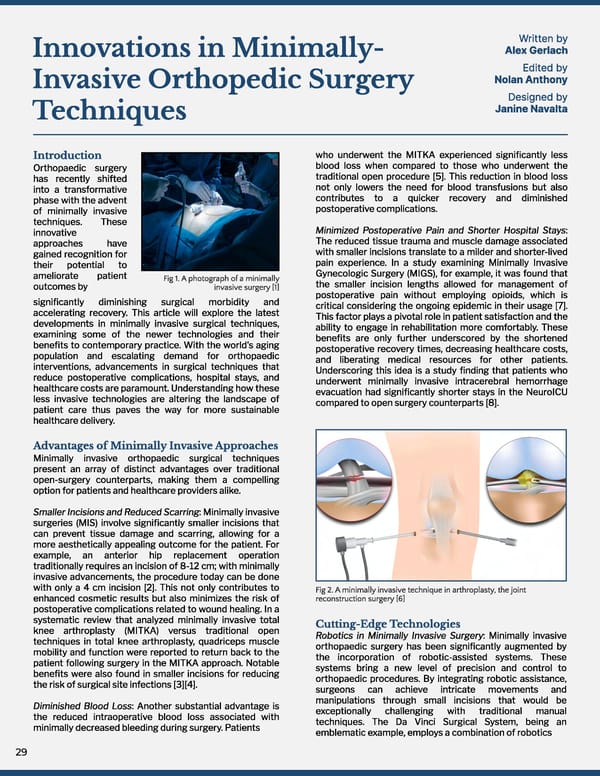Written b礀 Alex Gerlach Innovations in Minimally- Edited b礀 Nolan Anthony Invasive Orthopedic Surgery Designed b礀 Janine Navalta Techniques who underwent the MITKA experienced signi昀椀cantly less Introduction blood loss when compared to those who underwent the Orthopaedic surgery traditional open procedure [5]. This reduction in blood loss has recently shifted not only lowers the need for blood transfusions but also into a transformative contributes to a quicker recovery and diminished phase with the advent postoperative complications㠀 of minimally invasive techniques. These Minimized Postoperative Pain and Shorter Hospital Stays: innovative The reduced tissue trauma and muscle damage associated approaches have with smaller incisions translate to a milder and shorter-lived gained recognition for pain experience. In a study examining Minimally Invasive their potential to Gynecologic Surgery (MIGS), for example, it was found that ameliorate patient Fig 1. A photograph of a minimally the smaller incision lengths allowed for management of outcomes by invasive surgery [1] postoperative pain without employing opioids, which is signi昀椀cantly diminishing surgical morbidity and critical considering the ongoing epidemic in their usage [7]. accelerating recovery. This article will explore the latest This factor plays a pivotal role in patient satisfaction and the developments in minimally invasive surgical techniques, ability to engage in rehabilitation more comfortably. These examining some of the newer technologies and their bene昀椀ts are only further underscored by the shortened bene昀椀ts to contemporary practice. With the world's aging postoperative recovery times, decreasing healthcare costs, population and escalating demand for orthopaedic and liberating medical resources for other patients. interventions, advancements in surgical techniques that Underscoring this idea is a study 昀椀nding that patients who reduce postoperative complications, hospital stays, and underwent minimally invasive intracerebral hemorrhage healthcare costs are paramount. Understanding how these evacuation had signi昀椀cantly shorter stays in the NeuroICU less invasive technologies are altering the landscape of compared to open surgery counterparts [8]. patient care thus paves the way for more sustainable healthcare delivery. Advantages of Minimally Invasive Approaches Minimally invasive orthopaedic surgical techniques present an array of distinct advantages over traditional open-surgery counterparts, making them a compelling option for patients and healthcare providers alike㠀 Smaller Incisions and Reduced Scarring: Minimally invasive surgeries (MIS) involve signi昀椀cantly smaller incisions that can prevent tissue damage and scarring, allowing for a more aesthetically appealing outcome for the patient. For example, an anterior hip replacement operation traditionally requires an incision of 8-12 cm; with minimally invasive advancements, the procedure today can be done with only a 4 cm incision [2]. This not only contributes to Fig 2. A minimally invasive technique in arthroplasty, the joint reconstruction surgery [6] enhanced cosmetic results but also minimizes the risk of postoperative complications related to wound healing. In a systematic review that analyzed minimally invasive total Cutting-Edge Technologies knee arthroplasty (MITKA) versus traditional open Robotics in Minimally Invasive Surgery: Minimally invasive techniques in total knee arthroplasty, quadriceps muscle orthopaedic surgery has been signi昀椀cantly augmented by mobility and function were reported to return back to the the incorporation of robotic-assisted systems. These patient following surgery in the MITKA approach. Notable systems bring a new level of precision and control to bene昀椀ts were also found in smaller incisions for reducing orthopaedic procedures. By integrating robotic assistance, the risk of surgical site infections [3][4].⨀ surgeons can achieve intricate movements and manipulations through small incisions that would be Diminished Blood Loss: Another substantial advantage is exceptionally challenging with traditional manual the reduced intraoperative blood loss associated with techniques. The Da Vinci Surgical System, being an minimally decreased bleeding during surgery. Patients emblematic example, employs a combination of robotics 29
 Penn Healthcare Review Fall 2023 Journal— Sports Medicine Page 33 Page 35
Penn Healthcare Review Fall 2023 Journal— Sports Medicine Page 33 Page 35